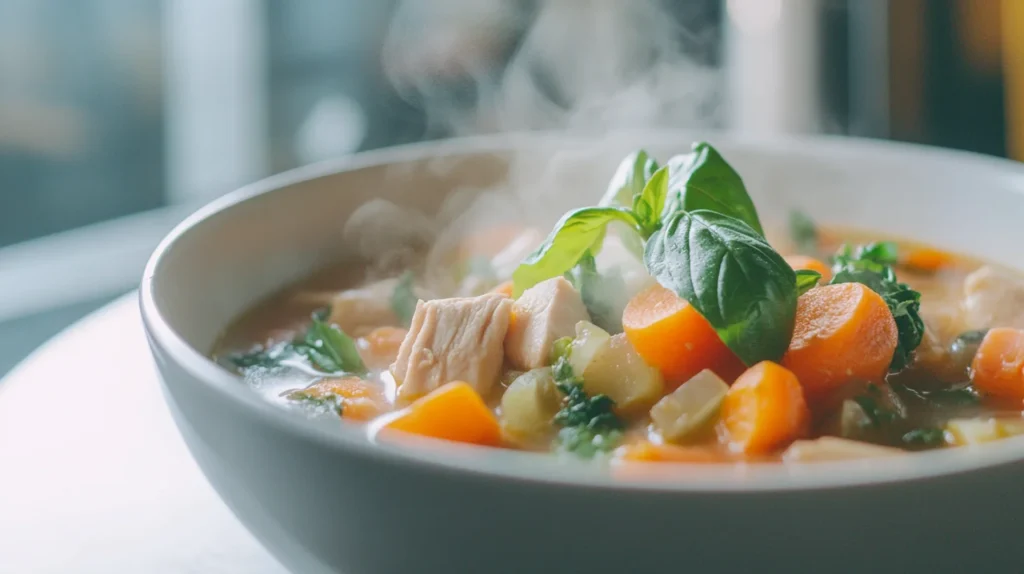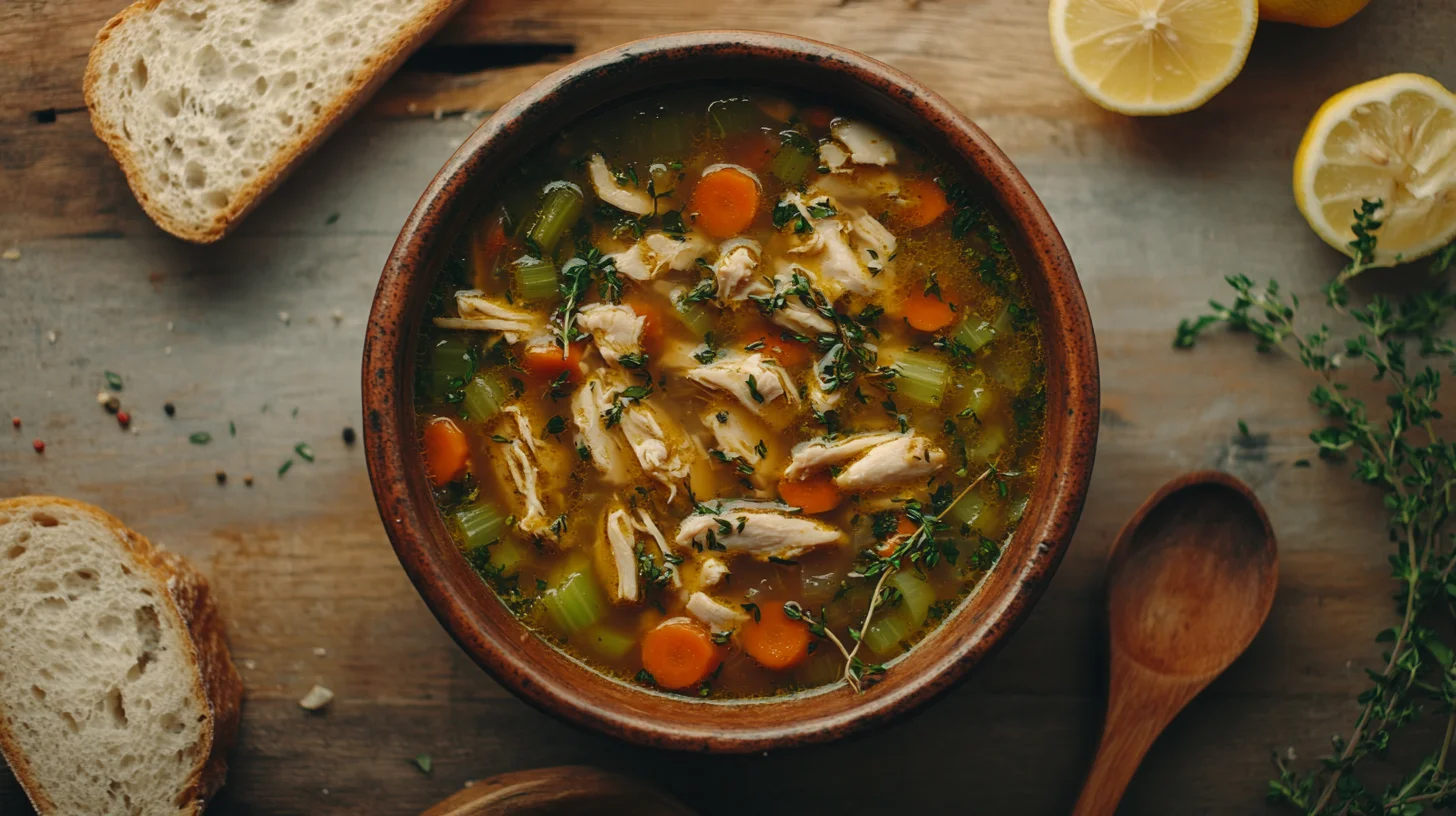For generations, soup has been a go-to source of comfort—a warm, healing remedy for both body and soul. Among the many versions across cultures, the Italian Penicillin Soup stands out with its Mediterranean flair. Similar to the beloved “Jewish Penicillin,” this Italian twist features a rich blend of garlic, herbs, chicken broth, and vibrant vegetables that nourish deeply and taste amazing.
More than just a cold-fighting soup, it’s a dish rooted in tradition and natural wellness. Packed with immune-boosting ingredients like thyme, olive oil, and seasonal produce, it brings together flavor and function in every spoonful.
Whether you’re recovering from illness, boosting your immune system, or simply craving a cozy, rustic meal, this recipe is a timeless kitchen remedy. In this guide, you’ll discover the story behind the soup, its health benefits, and a simple step-by-step recipe to recreate it at home.
So tie on your apron, gather your ingredients, and let the healing magic of Italian comfort food begin. 🍲

What Is Italian Penicillin Soup Recipe?

Origins in Italian Cuisine
The term “Italian Penicillin Soup Recipe” may sound like a modern nickname, but the roots of this recipe run deep through Italy’s culinary history. In fact, the concept of medicinal soup can be traced back to rural kitchens in regions like Tuscany, Sicily, and Lazio, where grandmothers would craft seasonal broths from whatever herbs, bones, and vegetables they had on hand. While there’s no single version of this soup that defines the entire country, its essence—fresh ingredients cooked slowly for maximum nutrition—is a staple of Italian home remedies.
Italian cuisine places a strong emphasis on “la cucina povera”—the cooking of the poor—which focuses on using simple, wholesome ingredients to create deeply flavorful dishes. In the case of Italian Penicillin Soup, this means using the bones and trimmings from a chicken, hardy herbs like rosemary and bay leaf, nutrient-rich vegetables like carrots and fennel, and olive oil not just for flavor, but also for its anti-inflammatory properties.
What makes it different from other broths is how it is built: layer upon layer of flavor, often beginning with sautéed aromatics, followed by simmered broth and slow-cooked greens. The resulting dish is both nourishing and restorative.
If you’re a fan of feel-good dishes that are both nutritious and delicious, try our creamy and spicy Buffalo Chicken Cauliflower Casserole — it’s another recipe packed with warmth and wellness.
Comparison with Jewish Penicillin (Chicken Soup)
Italian Penicillin Soup Recipe and Jewish Chicken Soup share many healing qualities—both are protein-rich, broth-based, and great for the immune system. But the Italian version stands out with its Mediterranean touch: olive oil, garlic, herbs, and a mix of colorful vegetables.
While Jewish soup often features a clear broth with matzo balls or noodles, the Italian one builds flavor from a sofritto base and includes pasta like orzo or farro. It’s earthier, more herbaceous, and sometimes spiced with chili flakes and lemon zest for added warmth and sinus relief.
Beyond comfort, the Italian version also supports digestion and reduces inflammation, thanks to its diverse blend of nourishing ingredients.
Benefits of Italian Penicillin Soup Recipe

More than just a comforting meal, Italian Penicillin Soup Recipe is a carefully balanced combination of ingredients with powerful health benefits. Every component, from garlic to greens, contributes to the body’s natural healing processes, making this dish a holistic wellness remedy. Let’s explore the science and tradition behind the soup’s health-boosting reputation.
Natural Antibiotics
Garlic – The Heart of Natural Healing
Garlic is the cornerstone of many healing recipes across cultures, and Italian Penicillin Soup Recipe is no exception. Known for its potent antimicrobial, antiviral, and antibacterial properties, garlic helps the body fight infections. It contains allicin, a sulfur compound released when raw garlic is chopped or crushed, which acts as a natural antibiotic. Including several cloves of garlic in this soup helps clear sinus congestion, reduce inflammation, and support immune responses.
Onion – Nature’s Flu Fighter
Onions are another traditional ingredient with natural antibiotic qualities. Rich in antioxidants and sulfur-containing compounds, onions have been used for centuries to combat respiratory conditions. They not only provide a depth of flavor but also help cleanse the blood, reduce fever, and soothe coughs—making them an essential part of this therapeutic broth.
Fresh Herbs – Oregano, Thyme, and Basil
These aromatic herbs are packed with polyphenols and flavonoids—natural antioxidants that fight free radicals and reduce inflammation. Oregano is particularly known for its antimicrobial properties, thyme is a powerful expectorant that helps relieve cough and congestion, and basil contributes anti-inflammatory benefits and a calming effect on the digestive system.
Immune-Boosting Ingredients
Chicken Broth – The Healing Base
At the core of Italian Penicillin Soup Recipe lies a rich, slow-simmered chicken broth. Bone-in chicken parts provide essential minerals like calcium, magnesium, and phosphorus, while the gelatin from bones supports gut health and strengthens the immune barrier. This nutrient-dense base hydrates the body, replenishes electrolytes, and delivers warmth and comfort with every spoonful.
Carrots, Celery, and Fennel
These vegetables not only enhance flavor but also contribute valuable vitamins and minerals. Carrots are high in beta-carotene, a precursor to Vitamin A, which is vital for immune function. Celery offers antioxidants and fiber that support digestion, while fennel adds a gentle, soothing effect on the stomach and respiratory system.
Leafy Greens – Spinach, Kale, or Escarole
Dark leafy greens are nutrient powerhouses loaded with Vitamins A, C, and K, plus iron and folate. These greens detoxify the liver, support circulation, and reinforce the immune system. They’re added toward the end of the cooking process to retain their nutrients and maintain texture.
Digestive and Anti-Inflammatory Support
Olive Oil – Liquid Gold
Extra virgin olive oil is more than a healthy fat—it’s a proven anti-inflammatory food rich in oleocanthal, which mimics the effects of ibuprofen. Using it as a base for the sofritto (a sauté of garlic, onion, and celery) enhances the soup’s flavor and adds powerful antioxidants that aid digestion and reduce swelling in the body.
Ginger and Lemon
Although not always traditional, ginger and lemon are excellent modern additions to Italian Penicillin Soup. Ginger aids in digestion and acts as an anti-nausea agent, while lemon adds Vitamin C and supports detoxification. Both ingredients also help open nasal passages and refresh the palate.
Parsley – More Than Just Garnish
Often overlooked, parsley is rich in chlorophyll, which detoxifies the body, and is a great source of Vitamin K for bone health and blood clotting. It also supports kidney function and freshens breath—a small addition with major benefits.
With these potent ingredients, Italian Penicillin Soup Recipe goes far beyond comfort food. It becomes a powerful, natural alternative to over-the-counter remedies—supporting the immune system, reducing inflammation, aiding digestion, and promoting overall vitality.
Essential Ingredients You’ll Need
The magic of Italian Penicillin Soup Recipe lies in the harmony of its ingredients. Each one contributes something unique—whether it’s immune-boosting vitamins, anti-inflammatory compounds, or simply comforting flavor. Below is a complete list of the 17 core ingredients that form the foundation of this restorative soup.
Looking for other creative ways to use chicken? Our White Chicken Lasagna Soup offers another warm, healing bowl perfect for chilly nights.
Protein Base
1. Whole Chicken or Bone-In Chicken Thighs
Using a whole chicken or bone-in thighs adds both depth of flavor and vital nutrients to the broth. The bones release collagen, gelatin, and amino acids, which support joint, gut, and immune health.
2. Chicken Stock or Bone Broth
If you’re not using a whole chicken to make your own stock, use high-quality bone broth as your base. It contains essential minerals and supports hydration while amplifying the nutritional value of the soup.
3. Optional – Beef Marrow Bones
For an even richer broth, consider adding a few beef marrow bones. They add umami flavor and boost the soup’s restorative properties, especially for energy and joint health.
Vegetables & Greens
4. Onion
A foundational aromatic, onions are rich in antioxidants and sulfur compounds. They help detoxify the body and build flavor from the very first step of cooking.
5. Garlic
Used generously, garlic provides antiviral, antibacterial, and anti-inflammatory benefits. It’s also essential for flavor, giving the soup its classic Italian depth.
6. Carrots
Loaded with beta-carotene, carrots add both sweetness and nutrition. They support eye health and immune function.
7. Celery
Celery offers crunch, fiber, and a unique set of antioxidants. It’s part of the traditional Italian sofritto base and plays a major role in building complexity in the soup.
8. Fennel
This Mediterranean favorite adds a light anise flavor and supports digestion. Fennel also calms bloating and soothes the gut lining.
9. Leafy Greens (Spinach, Kale, or Escarole)
Choose any dark green of your liking. Spinach is mild and soft, kale is hearty and fibrous, and escarole is slightly bitter. All are high in iron, folate, and Vitamin K.
Herbs & Aromatics
10. Fresh Oregano
This herb offers antibacterial benefits and a strong earthy flavor. Oregano also supports respiratory health, which is especially helpful when sick.
11. Thyme
Thyme is a natural decongestant with anti-inflammatory compounds. It works wonders in broths and stews, helping with both flavor and healing.
12. Basil
Basil adds a fragrant lift to the soup. It’s rich in antioxidants and has antibacterial properties that enhance immune function.
13. Bay Leaves
Bay leaves give subtle depth to soups when simmered over time. They also support digestion and help balance strong flavors.
Healing Add-Ons
14. Extra Virgin Olive Oil
Used to sauté the aromatics at the beginning of the recipe, olive oil contains oleocanthal, a natural compound that reduces inflammation. It’s the base of traditional Italian sofritto.
15. Fresh Ginger (Optional but Recommended)
Ginger brings a peppery warmth and helps with nausea, digestion, and inflammation. Though not traditional in Italian cuisine, it’s an excellent modern healing addition.
16. Fresh Lemon Juice & Zest
A splash of lemon juice at the end of cooking brightens the soup and boosts Vitamin C. Lemon zest adds fragrance and supports liver detoxification.
17. Fresh Parsley
Used as a garnish or stirred in during the final minutes, parsley adds freshness and is rich in chlorophyll, vitamins, and minerals. It’s often the finishing touch in many Italian dishes.
These 17 ingredients combine to create a flavorful, immune-supportive, and comforting bowl of soup that’s both timeless and timely. Whether you’re battling a cold, recovering from illness, or just want to feel rejuvenated, this ingredient list ensures your soup works as medicine.
Step-by-Step Italian Penicillin Soup Recipe

Now that you’ve got your ingredients lined up, it’s time to put everything together into a beautiful, nourishing bowl of Italian Penicillin Soup. This recipe follows a traditional preparation method used in many Italian households, enhanced with a few modern healing touches.
Prep Time, Cook Time, and Servings For Italian Penicillin Soup Recipe
| Prep Time | Cook Time | Total Time | Servings |
|---|---|---|---|
| 20 minutes | 1 hour 30 minutes | 1 hour 50 minutes | 6–8 servings |
Tip: If you’re short on time, this Italian Penicillin Soup Recipe can also be adapted for a slow cooker or pressure cooker—details below.
Preparation Instructions For Italian Penicillin Soup Recipe
Ingredients Recap:
- 1 whole chicken or 6–8 bone-in chicken thighs
- 8 cups chicken stock or bone broth
- 2 tablespoons extra virgin olive oil
- 1 large onion, chopped
- 4–5 garlic cloves, minced
- 2 carrots, chopped
- 2 celery stalks, chopped
- 1 fennel bulb, sliced
- 2 cups chopped leafy greens (spinach, kale, or escarole)
- 1 teaspoon fresh thyme (or ½ tsp dried)
- 1 teaspoon dried oregano
- 1 teaspoon fresh basil, chopped (optional)
- 2 bay leaves
- 1-inch knob of fresh ginger, grated (optional)
- Zest and juice of 1 lemon
- Salt and black pepper, to taste
- Fresh parsley, chopped, for garnish
Cooking Steps For Italian Penicillin Soup Recipe:
Step 1: Sauté the Aromatics (Sofritto Base)
In a large stockpot or Dutch oven, heat the olive oil over medium heat. Add chopped onions, celery, and carrots (the Italian soffritto) and cook for 6–8 minutes, stirring occasionally until softened and golden. Add the minced garlic, sliced fennel, ginger (if using), thyme, and oregano. Cook for another 2–3 minutes until fragrant.
Step 2: Add the Chicken & Broth
Place your whole chicken or chicken thighs into the pot. Pour in the chicken stock, making sure the meat is fully submerged. Add the bay leaves. Bring to a boil, then reduce to a simmer. Skim off any foam or impurities that rise to the top.
Step 3: Simmer and Develop Flavors
Cover the pot partially and let the soup simmer for at least 1 hour. The longer you simmer, the richer the broth will be. If using a whole chicken, remove it after about an hour, let it cool slightly, shred the meat, and discard the bones and skin. Return the shredded chicken to the soup.
Step 4: Add Greens and Final Touches
Add your leafy greens to the pot and simmer for another 5–10 minutes. Stir in the lemon zest and juice, and season with salt and freshly cracked black pepper. Remove the bay leaves before serving.
Step 5: Garnish and Serve
Ladle the soup into bowls, and top with fresh chopped parsley. Drizzle with a little olive oil and a sprinkle of grated parmesan (optional) for extra richness.
💡 For extra healing power, pair with warm tea infused with ginger and honey or sip a small glass of elderberry juice after your meal.
Craving a lighter Mediterranean meal? Consider trying our Greek Chicken Bowls—they’re packed with the same immune-friendly ingredients in a different form.
Serving Suggestions For Italian Penicillin Soup Recipe

This healing Italian Penicillin Soup Recipe can stand on its own, but here are some delicious ways to elevate the experience:
- Serve with rustic Italian bread for dipping or tearing directly into the soup.
- Add a scoop of cooked pasta like orzo, ditalini, or farro for a heartier meal.
- Top with freshly grated Pecorino Romano or Parmesan cheese for a cheesy twist.
- Add a pinch of chili flakes or red pepper oil for a warming kick.
- Serve with a side of roasted vegetables or a small arugula salad dressed with lemon and olive oil.
This version of Italian Penicillin Soup Recipe is as satisfying to make as it is to eat. Whether you’re cooking for yourself, a loved one who’s under the weather, or just want to nourish your body from the inside out, this soup delivers on all fronts.
Tips to Customize the Italian Penicillin Soup Recipe
One of the best things about Italian Penicillin Soup Recipe is its adaptability. Whether you’re vegetarian, watching sodium intake, or simply want to adjust the flavors to suit your palate, there are many ways to tweak this recipe without sacrificing its healing powers.
Making It Vegetarian For Italian Penicillin Soup Recipe
Swap the Chicken for Legumes or Mushrooms
To make a vegetarian version of this Italian Penicillin Soup Recipe, replace the chicken with protein-rich legumes such as cannellini beans or chickpeas. These will add bulk and nourishment while maintaining the Mediterranean flavor profile.
Use Vegetable Broth with Mushroom Base
Choose a hearty vegetable broth, ideally with dried or fresh shiitake or cremini mushrooms to mimic the umami depth that chicken provides. Mushrooms also offer their own immune-supporting benefits.
Extra Healing Boosters For Italian Penicillin Soup Recipe
Include additional anti-inflammatory vegetables like zucchini, leeks, or sweet potatoes. Add turmeric for color and immune support, and use miso paste or nutritional yeast for extra savoriness.
🥦 Tip: Blend a portion of the broth with some of the vegetables to thicken the soup naturally without cream or flour.
Spice and Flavor Adjustments
Add Heat with Red Chili Flakes
If you like a little warmth, a pinch of red chili flakes or a sliced red pepper can elevate the flavor and open up sinuses—a perfect remedy during cold season.
Citrus Variations
Instead of lemon, try orange zest for a subtle sweetness or lime juice for a unique citrusy twist. Both enhance flavor while still supporting digestion and immunity.
Experiment with Fresh Herbs
Italian staples like marjoram, rosemary, and sage can also be used. Adding fresh herbs at the end of cooking preserves their delicate oils and maximizes flavor.
For veggie-forward meal inspiration, you’ll love our bright and crisp Pear Salad — a perfect side to your soup.
Storage and Freezing Tips
Refrigerator Storage
Store leftover soup in airtight containers in the fridge for up to 4–5 days. The flavors often deepen overnight, making it even better the next day.
Freezer-Friendly Instructions For Italian Penicillin Soup Recipe
Italian Penicillin Soup Recipe freezes beautifully. Cool the Italian Penicillin Soup Recipe completely, transfer to freezer-safe containers (leaving room for expansion), and freeze for up to 3 months. For best results, freeze without pasta or greens, and add those fresh when reheating.
Reheating Tips For Italian Penicillin Soup Recipe
Reheat gently on the stovetop over medium-low heat. If frozen, thaw in the refrigerator overnight before reheating. Add fresh parsley, lemon juice, or a splash of olive oil before serving to revive the flavors.
Common Mistakes to Avoid
To get the full health benefits and rich flavor of Italian Penicillin Soup Recipe, avoid these common pitfalls that can turn a healing elixir into a bland or mushy mess.
Overcooking the Greens
Leafy greens like spinach and kale should be added during the final minutes of cooking. Simmering them too long causes them to lose their vibrant color, nutrients, and texture. If using delicate greens like spinach, stir them in after the heat is turned off to wilt gently.
Not Layering the Flavors For Italian Penicillin Soup Recipe
Some cooks are tempted to toss everything into the pot and boil it all at once. While this may be faster, it sacrifices depth of flavor. Sautéing your aromatics first (onions, garlic, celery, carrots) in olive oil builds a flavor base that’s essential to an authentic Italian soup.
Using Low-Quality Broth
The broth is the backbone of the entire soup. Using watery or flavorless store-bought broth results in a bland final product. If you can’t make homemade broth, choose high-quality, low-sodium organic broth and enhance it with extra herbs and a splash of lemon juice.
Skipping the Acid For Italian Penicillin Soup Recipe
Many forget to add an acid like lemon juice or vinegar. This small step at the end brightens all the flavors and balances the richness of the Italian Penicillin Soup Recipe. Without it, the soup can taste flat, no matter how well-seasoned.
Overloading with Pasta or Rice
While it’s tempting to turn this into a pasta-heavy Italian Penicillin Soup Recipe, too much pasta or rice can soak up all the broth and overpower the delicate balance. If adding grains, keep them to about ½ cup cooked per pot and cook them separately if planning to store leftovers.
🛑 Pro Tip: Keep pasta and soup separate during storage to avoid soggy textures.
These tips ensure that your Italian Penicillin Soup Recipe remains a consistent, flavorful, and healing go-to dish for any occasion—whether you’re under the weather or just craving something wholesome and satisfying.
Frequently Asked Questions
What’s in Italian Penicillin Soup Recipe?
Italian Penicillin Soup Recipe typically includes a nourishing blend of ingredients known for their healing properties. Common ingredients are bone-in chicken or chicken thighs, chicken broth, onions, garlic, celery, carrots, and leafy greens like spinach or kale. Herbs like thyme, oregano, and bay leaves contribute flavor and immune support, while lemon juice, parsley, and extra virgin olive oil offer anti-inflammatory and antioxidant benefits. Optional add-ons like ginger, fennel, or even pastina can personalize the recipe even further.
Why do they call it Italian Penicillin Soup Recipe?
The name “Italian Penicillin Soup Recipe” is a playful nod to Jewish Chicken Soup, often called “Jewish Penicillin” because of its perceived healing power against colds and flu. Italians put their own twist on the concept with Mediterranean ingredients like olive oil, garlic, herbs, and greens that not only comfort the sick but also contain natural medicinal qualities. This traditional soup is believed to help fight infections, soothe the digestive tract, reduce inflammation, and boost immunity—similar to the effect of penicillin, albeit naturally.
What is the most famous soup in Italy?
While many regional soups are beloved across Italy, Minestrone is arguably the most famous. It’s a thick, hearty vegetable soup often made with beans, pasta or rice, and seasonal vegetables, and varies widely by region. Other popular Italian soups include Ribollita from Tuscany, Stracciatella (egg-drop soup), and of course, Italian Penicillin Soup, especially in home kitchens focused on wellness and comfort.
Why does pastina make you feel better?
Pastina, meaning “little pasta” in Italian, is often used in brothy soups for children and the sick because of its soothing texture, easy digestibility, and emotional comfort. It’s soft, warm, and light, which makes it gentle on the stomach, especially when you’re feeling unwell. In Italy, pastina is commonly cooked in broth with butter and cheese, offering a perfect combination of hydration, calories, and simplicity that helps restore energy and mood.
Why did they stop making pastina?
In the U.S., the discontinuation of certain brands of pastina (notably from Ronzoni) in 2023 caused an uproar among Italian-American families. The decision was due to manufacturing difficulties and declining availability of specific equipment. However, other pasta brands and small producers still make pastina or similar shapes, and it remains widely available in Italy and in many specialty stores. For those who miss it, orzo, stelline, or acini di pepe make great substitutes.
What do Italians eat when sick?
When feeling under the weather, Italians often turn to simple, easily digestible dishes that comfort the body without overwhelming the system. These include:
Italian Penicillin Soup (broth with vegetables and chicken)
Pastina in Brodo (tiny pasta in broth, often with butter and cheese)
Stracciatella Soup (egg-drop soup with broth and Parmesan)
Light risottos, boiled potatoes, or zucchini and rice soup
Herbal teas with lemon and honey
The emphasis is on warm, soothing, and nutrient-rich meals, often passed down from grandmothers and rooted in the Mediterranean way of healing.
Conclusion
Italian Penicillin Soup Recipe is more than just a meal—it’s comfort, tradition, and healing in every spoonful. Made with nourishing vegetables, herbs, and tender chicken, it brings together the best of Italy’s culinary wisdom and natural remedies.
Whether you’re fighting off a cold or simply craving something wholesome and soothing, this recipe offers both flavor and wellness in one bowl. With the guidance and tips shared above, you’re ready to prepare your own version of this timeless classic.
So next time you need a little comfort—trust in the healing magic of Italian Penicillin Soup. Even Nonna would approve. 🍲

Italian Penicillin Soup Recipe
Equipment
- Large stockpot or Dutch oven
- Sharp chef’s knife
- Cutting board
- Wooden spoon
- Soup ladle
- Fine mesh strainer (optional, for clear broth)
Ingredients
- 1 whole chicken 3–4 lbs or 6–8 bone-in chicken thighs
- 8 cups chicken broth or bone broth
- 2 tbsp extra virgin olive oil
- 1 large onion chopped
- 4 –5 garlic cloves minced
- 2 carrots chopped
- 2 celery stalks chopped
- 1 fennel bulb sliced
- 2 cups spinach kale, or escarole, chopped
- 1 tsp dried oregano
- 1 tsp fresh thyme or ½ tsp dried
- 1 tsp fresh basil chopped (optional)
- 2 bay leaves
- 1- inch fresh ginger grated (optional)
- Zest and juice of 1 lemon
- Salt and freshly ground black pepper to taste
- Fresh parsley chopped, for garnish
- Optional: Parmesan cheese chili flakes, pastina or orzo (cooked separately)
Instructions
- Sauté Aromatics: In a large pot, heat olive oil over medium heat. Add onion, carrot, and celery. Sauté 6–8 minutes until soft and golden.
- Add garlic, fennel, ginger (if using), oregano, thyme, and basil. Cook another 2–3 minutes until fragrant.
- Add Chicken & Broth: Place whole chicken or chicken thighs into the pot. Pour in broth. Add bay leaves. Bring to a boil, then reduce to simmer.
- Simmer: Simmer uncovered for 60–75 minutes. If using a whole chicken, remove, shred meat, discard bones/skin, and return meat to the pot.
- Add Greens: Stir in chopped spinach, kale, or escarole. Cook 5–10 more minutes until wilted but vibrant.
- Season: Add lemon zest and juice. Season with salt and pepper to taste.
- Serve: Garnish with parsley, a drizzle of olive oil, optional Parmesan, and chili flakes. Serve hot with crusty bread or a scoop of pastina/orzo.


This soup sounds like a perfect blend of tradition and health, offering both comfort and nourishment. The use of Mediterranean ingredients like olive oil, garlic, and herbs adds a unique twist to a classic remedy. It’s fascinating how it combines flavor and function, making it more than just a meal. The step-by-step guide makes it accessible for anyone to try at home. What makes this soup particularly effective for boosting the immune system compared to other recipes? German news in Russian (новости Германии)— quirky, bold, and hypnotically captivating. Like a telegram from a parallel Europe. Care to take a peek?
Thank you for your thoughtful comment! 😊 I’m so happy you noticed the balance between tradition and health in this soup. The Mediterranean ingredients really do bring both flavor and wellness benefits 🌿🍲. Great question — I’ll be adding a short note soon about how garlic, herbs, and olive oil support the immune system. Stay tuned!
Thank you so much for your kind words! 😊 I’m so glad you enjoyed it. And you’re absolutely right — nothing beats a comforting bowl of soup with a warm, cheesy Stromboli on the side 🥣🧀. Hope you try both soon and let me know what you think!